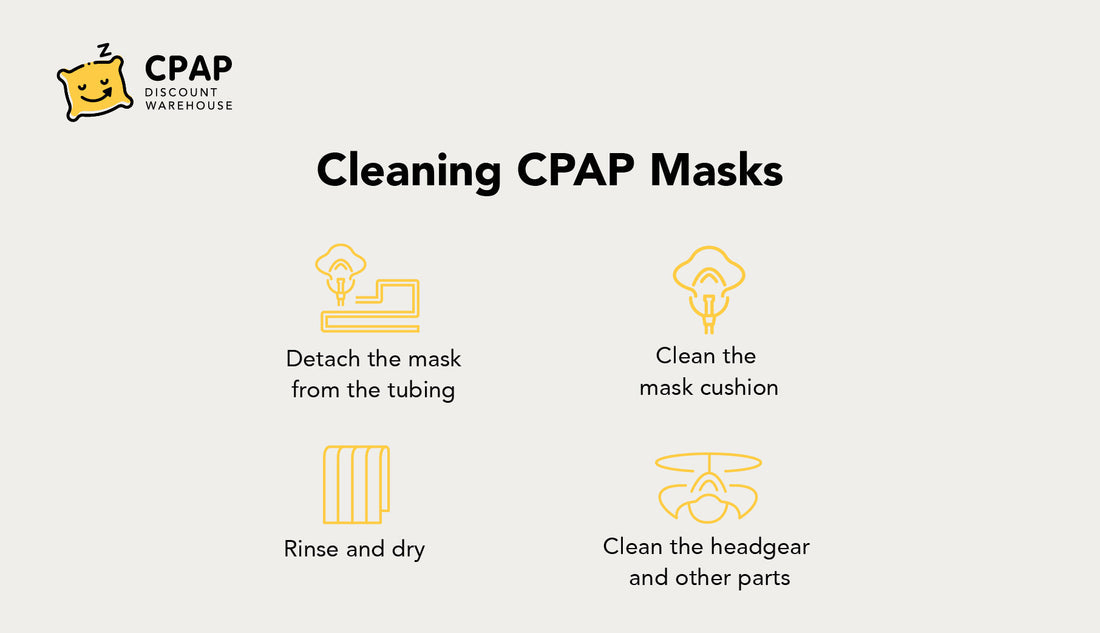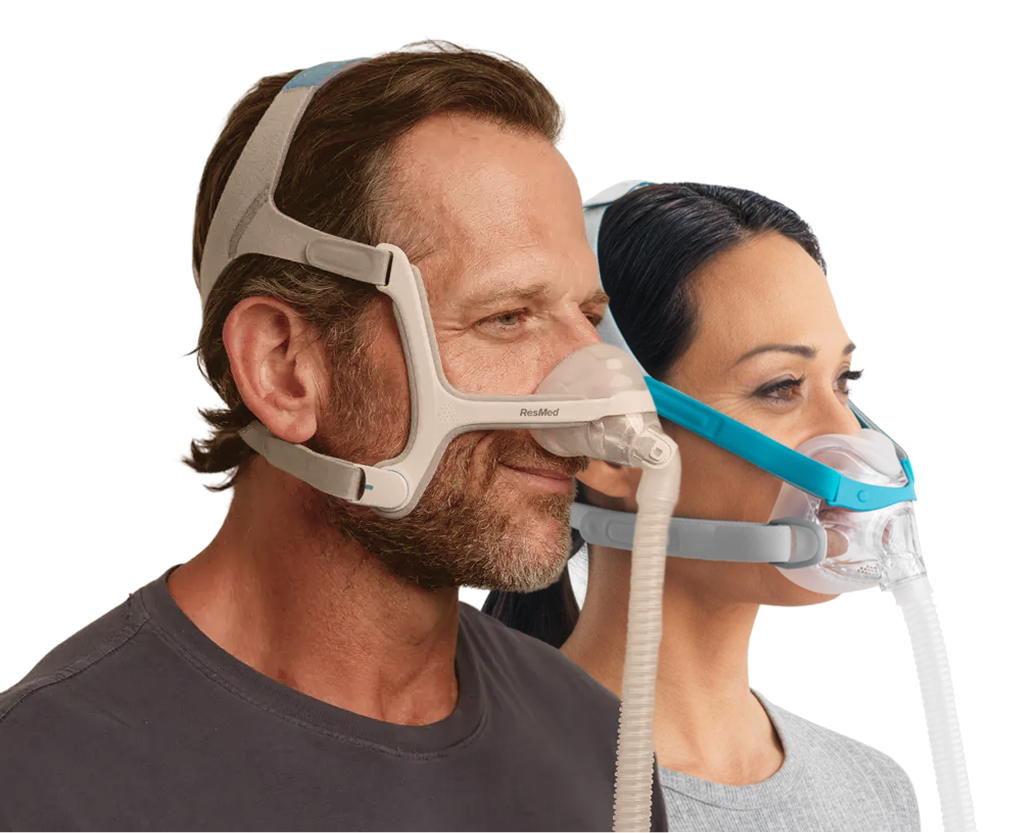Most CPAP accessories like masks, hoses and CPAP machine humidifier tanks can be cleaned with mild soap and water as described in the owner's manual. . Refer to the article below from CPAP Discount Warehouse to learn how to properly clean your CPAP equipment and extend its lifespan.
Disassemble your mask
Step 1: You’ll need to disassemble it carefully. Pull the cushion out from both ends of the frame to remove the quiet air vent.
Step 2: Gently peel the CPAP cushion away and slide the vent out from under the fastening tabs on the headgear and away from the frame.
Step 3: After detaching the headgear, close the fastening tabs to prevent them from damaging the fabric sleeves. When handling, squeeze the side buttons on the elbow and detach it from the frame. Now that you’ve disassembled your mask, you’re ready to start cleaning it.
How often clean CPAP mask?
Manufacturers and experts generally recommend cleaning CPAP components daily, while users should clean them at least once a week.
Daily cleaning
Step 1: Your mask should be cleaned regularly. The two components that require daily cleaning are the cushion and the quiet air vent.
Step 2: Soak the components in warm water with a mild liquid detergent, ensuring there are no bubbles trapped while soaking. Hand-wash them gently.
Step 3: Clean the quiet air vent with a soft-bristle brush, paying particular attention to the vent holes. For the AirTouch N30 cushion, hand-wash only do not use a bristle brush.
Step 4: Rinse all components thoroughly under running water. Squeeze the fabric cushion with a clean towel to remove excess water. Shake the quiet air vent to remove any excess water. Leave all parts to air-dry out of direct sunlight.

Weekly cleaning
Step 1: Weekly, cleaning the three components that should be cleaned weekly are your frame headgear and elbow.
Step 2: Soak the components in warm water with a mild liquid detergent ensure that there are no air bubbles while soaking, hand wash the components with a soft bristle brush.
Step 3: Thoroughly rinse the components under running water, squeeze the headgear out and fabric frame with a clean towel to remove excess water, leave them to air dry out of direct sunlight, reassemble your mask.

Reassemble your mask
Follow these steps to reassemble your CPAP mask.
Step 1: If the elbow ring was detached at any point, simply reinsert into the top of the frame, connect the elbow into the top of the frame, you should hear a click when it's securely attached with the Resmed logo on the headgear facing up.
Step 2: Following this, insert both CPAP straps of the headgear into the frame from the inside and fold the fastening tabs over to secure them, insert the vent into the cushion by aligning the tab on the cushion with a notch on the vent.
Step 3: Gently pull the cushion over the vent, connect the ends of the frame with a cushion ensuring the arrows on the cushion and frame are aligned.
Step 4: Now, your mask is fully reassembled and ready for you to use again. Refer to the user guide, for more information for even more help, download you myair app today.
Best soap to clean CPAP mask
Maintaining a clean CPAP mask is essential for hygiene, comfort, and prolonging equipment life. Below is a simple guide to the best soaps, sprays, wipes, and techniques including special care for memory-foam cushions.
CPAP mask cleaning spray
A CPAP cleaning spray is ideal for quick and convenient daily cleaning. These sprays are formulated to remove facial oils, bacteria, and odors without damaging the mask’s silicone or plastic materials.
To use, lightly spray the exterior and interior of your mask, then wipe with a soft cloth or CPAP wipe. Look for alcohol-free, fragrance-free options such as Purdoux CPAP Mask & Hose Spray, Viraclean Hospital Grade Disinfectant or ResMed Pure CPAP Cleaning Spray, these available at CPAP Discount Warehouse. Avoid household cleaners they can leave harmful residues or irritate your skin.
Wipes to clean CPAP mask
CPAP wipes offer an easy, no-rinse way to keep your mask fresh between deep cleans. Use them each morning to remove skin oils and dust buildup. Choose CPAP-approved wipes that are alcohol-free, latex-free, and unscented. Popular choices in Australia include ResMed CPAP Wipes and Clinell Universal Wipes. Never use baby wipes or household disinfectant wipes, as they can damage silicone materials.
Cleaning CPAP mask with vinegar
Immerse the humidifier tank weekly in hot water with a mild dish detergent or in a solution of 1 part vinegar and 9 parts room temperature water.
FAQs
What happens if you don't clean your CPAP mask?
Yes, masks can be a source of germs if they are not cleaned. Masks are worn on the face and come into contact with organisms on the skin. Over time, bacteria and oils on dirty masks can cause skin rashes or infections.
Why does my CPAP mask leaks after cleaning?
Ensure that the mask fits snugly against your face. A mask that leaks can cause dryness in the nose. If you frequently have to tighten the straps to prevent air from escaping, this means that the mask does not fit tightly. A CPAP machine equipped with a heated humidifier that connects to the device to generate air pressure can help.
What can i clean my CPAP mask with?
Gently clean the mask using a mild liquid detergent and warm drinking water, a soft brush, warm soapy water, and a clean dry cloth. Use distilled water with mild, unscented soap or mild liquid detergent and avoid using bleach, as it may damage the mask or leave dangerous residues. Follow the replacement schedule.
To get the best treatment for sleep apnea, it is important to thoroughly and regularly clean your CPAP equipment, including the mask, flexible tubing, and humidifier tank.






